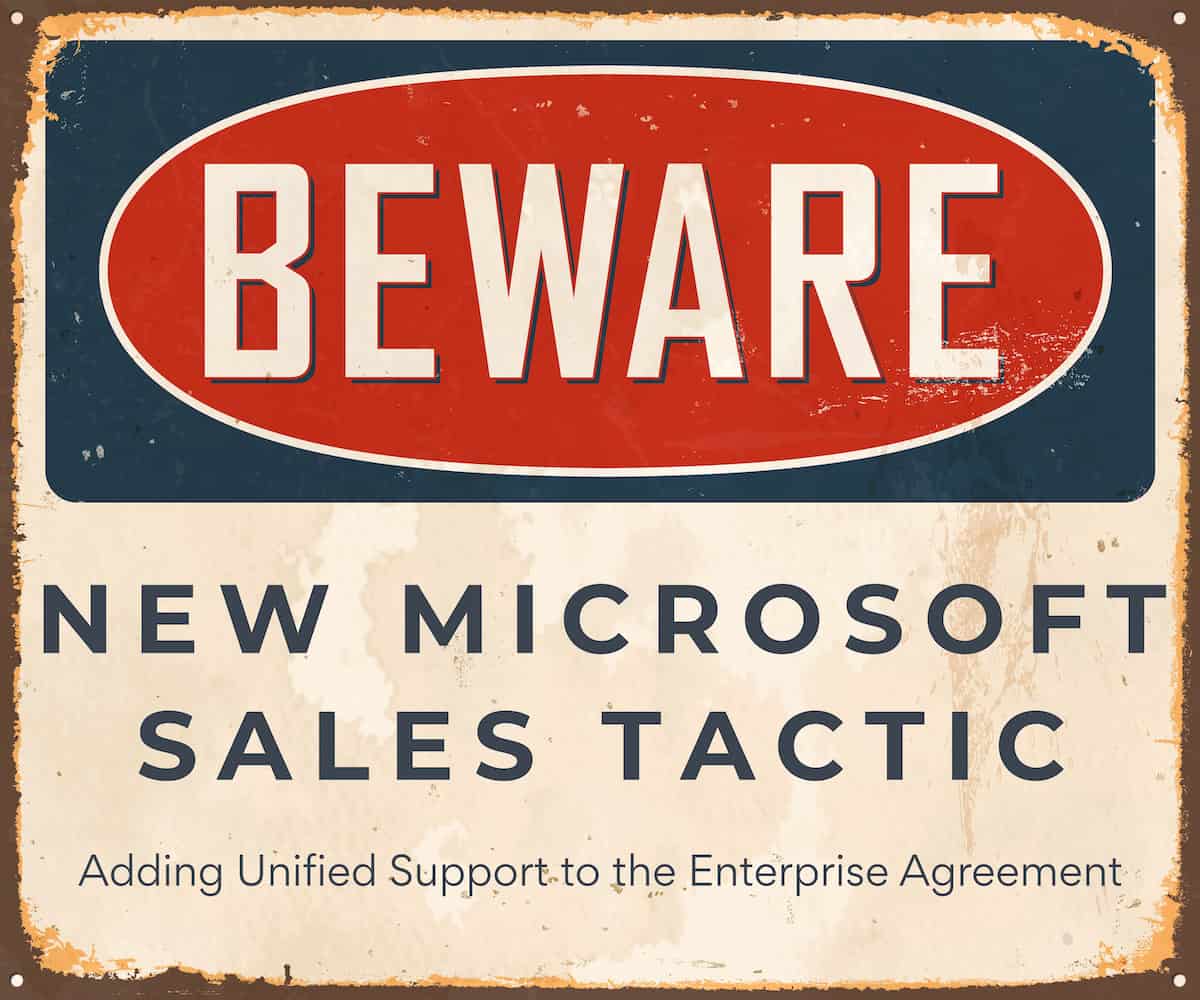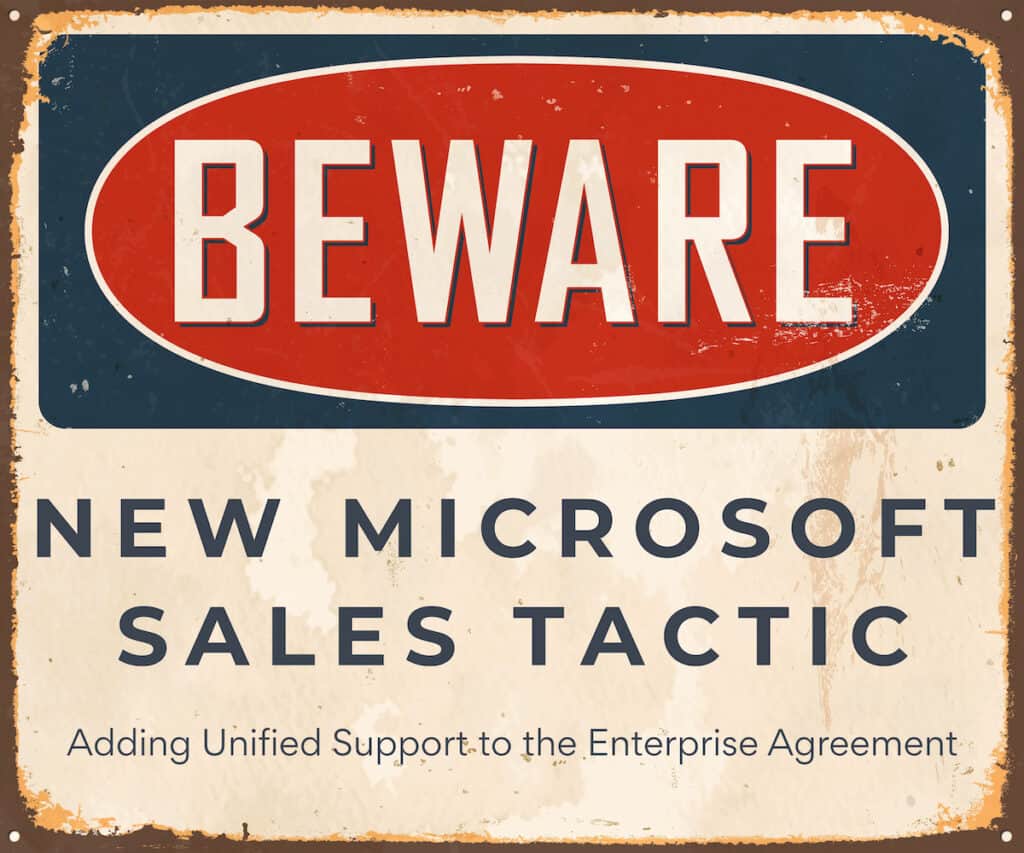

Beware of New Microsoft Sales Tactic – Adding Unified Support to Enterprise Agreement (EA).
- New Microsoft Sales Tactic – Add Support to Enterprise Agreement
- Uncouple Microsoft Support from the EA to Maximize Savings
- Coterminous EA and Support Contracts Often Independent of One Another
- No Unified Support Price Protection in Multi-year MS Enterprise Agreement
- Enterprise Procurement Teams Lose Cost Avoidance Opportunity
- Millions of Dollars in Unified Support Cost Savings at Stake
- Bundling or Tying Products and Services Increases Microsoft’s Profit
New Microsoft Sales Tactic – Add Support to Enterprise Agreement
Beware of a new Microsoft sales tactic in 2023 – adding Unified Support to the Enterprise Agreement (EA). Read the brief to understand the risks of combining the two or it could cost you dearly.
Audience: CIO and IT Executives | Sourcing, Procurement and Vendor Management

Uncouple Microsoft Support from the EA to Maximize Savings
ITAM and Gartner recommend not adding Unified Support to your Enterprise Agreement.
In the past, companies could gain concessions on Premier Support pricing as part of co-terminus EA agreements. With Unified Support, pricing is now formulaic and offers MS support sales reps much less wiggle room vs. what was Premier. There is no advantage to mixing the two conversations, so isolate them and negotiate independently.
Additionally, for most enterprises, a long term commitment to Unified Support is not advised since Microsoft third party support is going mainstream and delivering 2x faster support for 50% less. Third-party support for applications and databases from vendors such as Oracle and SAP has been a viable alternative to annual vendor maintenance and support contracts for years. That market was disrupted in 2005 as third-party support providers got started and is now available to Microsoft dependent enterprises.
Coterminous EA and Support Contracts Often Independent of One Another
Enterprises would do well to check the fine print of their Microsoft Enterprise Agreement and MS Unified Support contract renewal dates.
Microsoft sales teams may lead enterprise procurement teams to believe that their EA and support contacts are connected when in fact they are separate agreements that happen to have the same renewal date.
If this is the case in your enterprise, you are free to move to a third party Microsoft Support provider (2x faster, 50% less cost) to replace Unified with no impact on your EA or Microsoft relationship.
No Unified Support Price Protection in Multi-year MS Enterprise Agreement
While the idea of longer-term price certainty will be tempting, the support cost of future years is not truly locked in.
Microsoft is offering more multiyear Enterprise Agreements (EA) that include Unified Support. Procurement and Vendor Management leaders who need cost predictability from year to year may be tempted to sign an EA that includes Unified. While the idea of longer-term price certainty will be tempting, the cost of future years is not truly locked in. Multi-year Unified Support agreements tied to Microsoft EAs have several characteristics that create additional risk:
A true-up clause: If the enterprise’s spending on Microsoft products and services increases from the estimated year’s spending by more than the “buffer rate” (usually 5%), the cost will be recalculated based on “lock rates” provided by Microsoft for future years.
No cap on increases: Microsoft’s standard Unified Support agreement terms include no cap on the price. So if Azure spending skyrockets, the organization must pay based on the higher spending with no flexibility to renegotiate the price, or else drop support.
No true-down clause: Conversely, if an organization decides to move services off Azure to an alternative public cloud provider, its support costs will not decrease during the term of the contract.
No divestiture clause: Unified Support contracts lack any provision to reduce the cost of future years in the event of a divestiture of part of the organization.
No beneficial changes: Organizations in multiyear agreements may not get the advantages of improvements that Microsoft makes to Unified Support or new service capability of third-party providers, during the term of the agreement.
Enterprise Procurement Teams Lose Cost Avoidance Opportunity
Microsoft Enterprise Agreements are 3-year terms. If you include Unified Support in your EA, you are locked into Microsoft for support for at least 3 years.
This vendor lock-in may result in your enterprise’s inability to both avoid Unified support cost increases via annual true-up at Microsoft and take advantage of cost savings opportunities outside of Microsoft.
By adding Unified Support to your Microsoft EA, your organization may assume that its support costs will be contained. Unfortunately, this will not be the case if your cloud consumption is growing like most companies. Your enterprise’s support spend baseline will true-up once per year, most likely establishing a new and higher cost baseline for Microsoft support.
If IT Procurement or your EA negotiator bundles Unified Support with the Enterprise Agreement you will not be able to explore alternatives to Microsoft for at least 3 years. Analysts report 30-50% cost savings is possible with third-party Microsoft support. Gartner, IDC, and InfoTech and have each identified viable alternatives to Microsoft Unified Support. Organizations moving away from Microsoft earlier are able use their savings strategically to grow while others are shackled to their Microsoft EA.
Millions of Dollars in Unified Support Cost Savings at Stake
It pays to keep your Microsoft Enterprise Agreement separate from your Unified Support contract. In many cases, millions of dollars.
While Unified Support typically only makes up 4-6% of an Enterprise Agreement’s total cost, it is often worth $10M+, over 3 years, to Fortune 500 and Global 2000 companies.
In the past, some Sourcing and Procurement leaders have elected to play it safe with OEM support from Microsoft and not explore alternatives to Premier or Unified Support. However, record-high inflation and recessionary economic conditions are now forcing organizations of all sizes and industries to scrutinize their Microsoft spends.
Winning enterprises are responsibly cutting Microsoft support costs while maintaining quality with viable third-party support providers. Analyst market guides and Proof of Concepts are available for research and risk mitigation. Once satisfied, these forward-thinking organizations are able to use the millions in support cost savings to drive growth and outpace industry competitors.
Bundling or Tying Products and Services Increases Microsoft’s Profit
Sales professionals know that bundling services together yields better margins. Microsoft is an expert at bundling services and increasing margins of their enterprise customers.
Microsoft 365 licensing bundles for enterprises are a well-known example. On the other hand, Enterprise Agreements with Unified Support bundled together are less well-known but equally effective at driving support revenue at Microsoft.
By bundling Unified Support with the EA, Microsoft quietly picks up another 6-12% in margin over 3 years (Unified trues up annually) and avoids scrutiny and analysis of Unified Support’s rapidly expanding costs. Microsoft astutely understands that EA negotiators and IT Procurement may not have the time or appetite to dive into their Unified Support bill or engage Gartner, IDC, or InfoTech for assistance.
As a percentage of the overall Microsoft Enterprise Agreement, Unified Support looks insignificant, but when converted to real dollars over 3 years, it is often worth millions of dollars to enterprises.
Negotiators and IT Procurement should plan accordingly and analyze Unified Support costs outside the EA to fully reduce their overall Microsoft spend and preserve their enterprise IT budget over the next 3 years.
